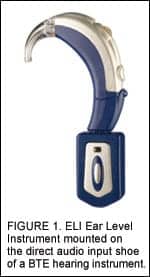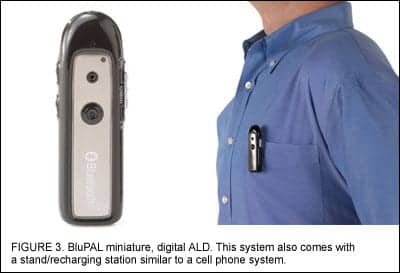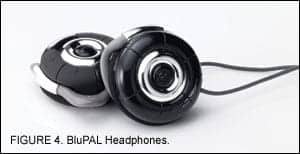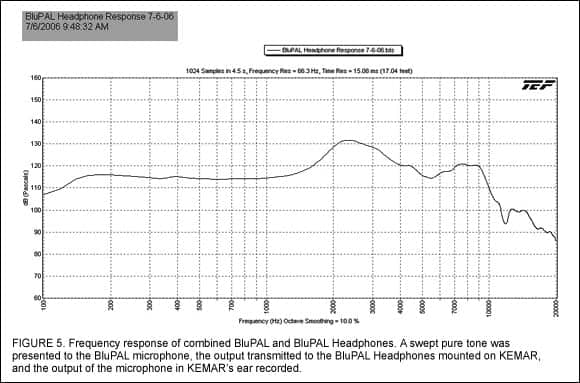Since the introduction of Bluetooth and the formation of the Bluetooth Special Interest Group (SIG) by five companies in 1998, Bluetooth technology has seen astounding growth. In 2005, the SIG welcomed its 5,000th member company, and the number of products using this wireless protocol continues to grow.
This article offers a brief update on Bluetooth terminology and developments, with special emphasis on those impacting hearing care. It will also describe the newest members of the growing collection of Bluetooth products from Starkey Labs and how they lead toward market convergence.
Bluetooth Profiles and Applications
A profile is a set of rules governing a specific Bluetooth application designed to ensure that devices from different manufacturers will work together. A recent count revealed 33 Bluetooth profiles designed for a variety of applications.1
Many hearing care professionals are already using Bluetooth’s Serial Port Profile (SPP) to program hearing aids with the NoahLink programming device. Another interesting profile currently in the early stages of development is the Medical Devices Profile (MDP), promising health-related telemetry from a variety of devices.
Most pertinent to audio applications in hearing care are three profiles:
1) Headset Profile (HSP);
2) Hands-Free Profile (HFP), and
3) Advanced Audio Distribution Profile (A2DP).
HSP and HFP are both designed for telephone communication with a bandwidth of approximately 300 Hz to 3,300 Hz and monaural presentation only. The newer A2DP is a high-end audio profile with a broader bandwidth and stereo capabilities. With a standard sampling rate of 44.1 kHz, the transmitted frequency response of A2DP applications is in the neighborhood of 100 Hz to 20 kHz.
Bluetooth and FM. A frequent question from hearing care professionals is whether Bluetooth devices can replace group FM systems in schools. Bluetooth was designed originally as a point-to-point technology—one sender to one receiver. In a classroom or meeting room, one transmitter on the lapel of a teacher or speaker will transmit to only one listener. Efforts are underway, however, to create multi-point devices that will transmit streaming audio to multiple receivers. When available, they may offer an alternative to FM classroom systems that is less expensive and less susceptible to issues of channel saturation and interference than current FM systems.
Bluetooth versions. Bluetooth specifications have progressed from the original Version 1.0 through Versions 1.1, 1.2, and 2.0. While the basic operations of successive versions are similar, they continue to improve in several respects. Version 1.2, for example, offered improved resistance to radio frequency (RF) interference, improved voice quality, faster pairing of devices, and higher transmission speeds compared with Version 1.1. Among other technical improvements, Version 2.0 offers yet higher transmission speeds and lower power consumption for better operating battery life. Each new Bluetooth version is backward compatible with preceding versions.
Versions 1.2 and 2.0 have sophisticated error-checking capability. Data (in our case, streaming audio) are transmitted via Bluetooth in digital packets. Occasionally, interference may cause a packet to be dropped, which sounds like a pop or click in the audio signal. With the error-checking capability in the newest versions, the loss of a packet is detected by the system, and the packet is re-sent by the transmitter, reducing interference and improving signal quality.
Bluetooth Range. The operating range of Bluetooth devices is determined by the device class:
• Class 3 devices have a range of up to 1 meter.
• Class 2 devices have a range of up to 10 meters.
• Class 1 devices have a range of up to 100 meters.
The majority of devices used for audio applications are Class 2 devices.
The Evolution and the Metamorphosis of a Bluetooth Product Line

Shortly after ELI’s release, Starkey introduced a Bluetooth receiver for normal-hearing people, called SoundPort, which is distinguished by its custom earmold to deliver a quality acoustic signal consistently, comfortably, and securely to the wearer’s ear. SoundPort offers to hearing care professionals a vehicle for expanding their practices into the normal-hearing market.
An updated device, SoundPort II (Figure 2), designed around Bluetooth version 1.2, will be available about the time this article is published. SoundPort II has two microphone options: either a directional microphone aimed toward the wearer’s mouth, or a boom microphone that puts the transducer right in front of the mouth. These microphone designs will improve the quality of the outbound voice of the SoundPort II wearer, while the updates in Version 1.2 will improve the inbound caller’s voice.

Several companies also offer devices that receive a Bluetooth signal from a cell phone and route it to the landline phones in a home. While this is not a hands-free option, it does represent a means of consolidating telephone subscriptions under one provider, instead of two. We fully expect these developments to represent a growing trend.

Not Your Father’s ALD
An earlier article in HR described plans for the creation of a Bluetooth Assistive Listening Device (ALD).4 This device, called BluPAL, is now a reality (Figure 3). PAL is an acronym for Personal Audio Link. Containing both omnidirectional and directional microphones and an auxiliary input, BluPAL uses Bluetooth Version 1.2 and can accommodate HSP, HFP, or A2DP profiles, depending on the transducer to which it is sending a signal.
With a length of 68 mm, BluPAL clips easily into a pocket or onto a lapel, or it can be placed on its stand. The rechargeable lithium-ion polymer battery has an operating life of 5 hours and requires 2 hours to fully recharge.
By sending an audio signal to ELI, BluPAL as an ALD is well suited to typical scenarios where signal-to-noise ratio (SNR) is especially challenging, such as at restaurants, parties, and moving vehicles. It essentially delivers the talker’s voice directly into the hearing aid, reducing surrounding noise significantly more than a directional hearing aid, and it is far less cumbersome than the typical FM alternatives.
Television listening by a hard-of-hearing person with a normal-hearing family member in the room is facilitated by placing the BluPAL transmitter on its stand in front of the television speakers (with the microphone on) and sending the audio output to ELI on the listener’s hearing aid. Alternatively, one might connect the audio output of the set directly to BluPAL’s auxiliary input.
Currently a Class 2 device, the next release of BluPAL will offer a Class 1 option. When available, BluPAL’s Class 1 option—with a range greater than the length of a football field —will extend its benefit for hard-of-hearing persons to meeting rooms, auditoriums, and places of worship.

The BluPAL Headphones (Figure 4) from Starkey Labs are designed as high-quality, lightweight, wireless, stereo transducers that receive streaming audio from BluPAL or other Bluetooth sources. The frequency response of the combination of BluPAL and the BluPAL Headphones does not begin to fall off until about 10 kHz (Figure 5), giving the wearer a much richer audio experience when connected to a television or any audio device.

Reactions from wearers who are hearing impaired, as well as normal-hearing wearers, indicate high satisfaction with the resulting sound quality. Used with BluPAL and any of the growing number of miniature MP3 players and iPods, the BluPAL Headphones are expected to be marketed to teens and young adults and represent a state-of-the-art, high-quality, trendy, listening option.
The BluPAL Headphones have a Master Dual Input capability, which allows switching from one Bluetooth source to another with one press of the control in the center of the left earphone. If the wearer is listening to music, and a call comes in on her Bluetooth-enabled cell phone, she merely presses the button to answer the phone, then presses it again to return to music after the call is finished. A directional microphone mounted on the left earphone picks up the wearer’s voice to transmit it to the cell phone.
Blurring the Lines: Is it an ALD, a Communication Device, or an Entertainment System?
As Starkey’s first Bluetooth product, ELI was intended as a communication device for hard of hearing persons, with the primary goal of allowing access to digital cell phones. The arrival of BluPAL further facilitates communication in very noisy places, with a new, streamlined device.
But it’s not all about communication. This technology also allows a hard of hearing person the option of using ELI to listen to television or any other audio signal source picked up and transmitted by BluPAL. Suddenly these communication devices have also become entertainment devices for hard-of-hearing people.
Headphones. Now BluPAL, the same device that improved communication for hard of hearing people, becomes an entertainment device in the form of BluPAL Headphones, transmitting high-quality music to the ears of hearing-impaired and normal-hearing people, simultaneously freeing them from the wires that have attached them to their music machines in the past.
Communication device or entertainment device? Device for hard of hearing people or for normal hearing people? We anticipate that markets may converge, and the boundaries between them may fade. The same wireless gadgetry that is making life easier and more enjoyable for hard of hearing people is also improving life for normal hearing persons.
This convergence may mark a time for us to re-evaluate our hearing aid practices and consider bridging the gap and serving two markets simultaneously.
References
1. Bluetooth: The official Bluetooth Web site. Available at: www.bluetooth.com/bluetooth; Accessed July 2006.
2. Yanz, JL, Roberts R, Sanguino J. A wearable Bluetooth device for hard-of-hearing people. The Hearing Review. 2005,12(5):38-41.
3. Yanz JL. Telephones and hearing instruments: issues, resolutions, and a new alternative. Hear Jour. 2005;58(10):41-48.
4. Yanz, JL. The future of wireless devices in hearing care: A technology that promises to transform the hearing industry. The Hearing Review. 2006;13(1):18-20, 93.
This article was submitted to HR by Jerry L. Yanz, PhD, senior trainer in the Education and Training Department, and Randall Roberts, director, and Tom Colburn, software engineer, of Special Products Engineering at Starkey Laboratories, Eden Prairie, Minn. Correspondence can be addressed to HR or Jerry L. Yanz, Starkey Laboratories Inc, 6600 Washington Ave S, Eden Prairie, MN 55344; e-mail: [email protected].





-300x264.gif)